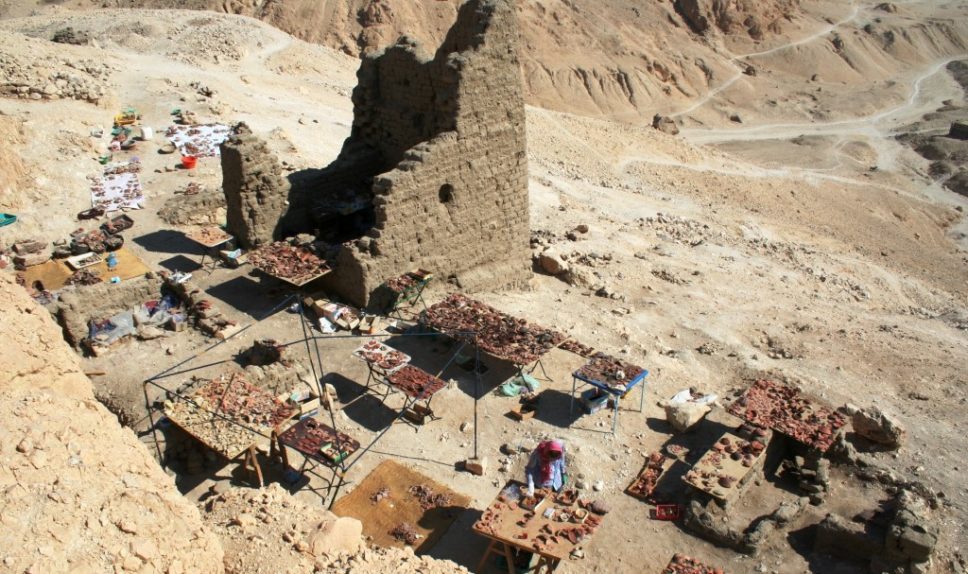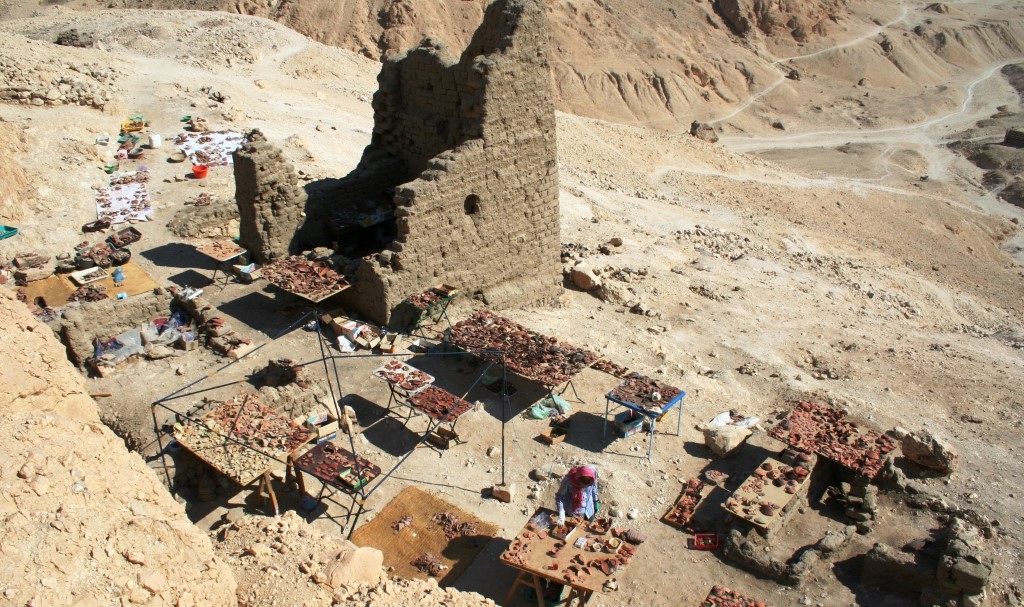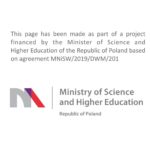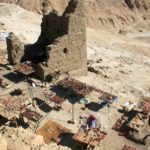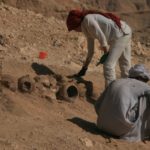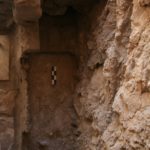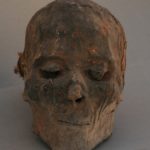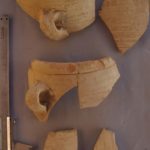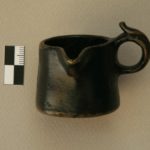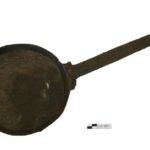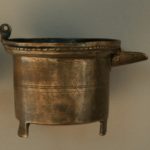Sheikh Abd el-Qurna
Sheikh Abd el-Gurna
el-Gurna
-
Project name:
Polish Archaeological Mission at Sheikh Abd el-Qurna (Hermitage in Tombs MMA 1151 and 1152)
البعثة الأثرية البولندية المصرية بالشيخ عبد القرنه -
Type of site:
Pharaonic tomb, Coptic hermitage
Location:
Egypt
Ancient ThebaidDating:
– From the Middle Kingdom to the Roman period (tomb used for the intended purpose with varying intensity in different periods; the second half of the 5th century – beginning of the 8th century)
Most interesting finds:
– Coptic manuscripts (Canons of Pseudo-Basil, Life of St Pisenthius, fragment of Book of Isaiah, Acta Petri apocrypha)
– Approximately 8,000 pottery vessels
– More than 325 Coptic and Greek ostraca
– Iron pan with a handle decorated with engraved depictions of animals and plants
History of research:
Dates of PCMA mission’s work:
2003–2016
Type of research:
Excavations, geophysical prospection, conservation
Directors:
Andrzej Ćwiek (2016)
Tomasz Górecki, Andrzej Ćwiek (2015)
Tomasz Górecki (2003–2014)
Aleksandra Pawlikowska-Gwiazda
Co-operating institutions:
– Polish Centre of Mediterranean Archaeology, University of Warsaw
– National Museum in Warsaw
– Adam Mickiewicz University in Poznań
Additional information:
The conservation of the manuscripts discovered in 2005 turned out to be so demanding that a separate subproject had to be established. In 2009–2014, National Science Centre’s grant no. Gr-2901 N N109 318337: “The functioning of the hermitage in Tomb 1152 in Gurna (Luxor) in the light of archaeological and textual data” was realized in the framework of the project. Additionally, in 2015 and 2016, Dr. Andrzej Ćwiek studied the Pharaonic structures in Tombs MMA 1151 and 1152.
Description of the site and research:
Tombs MMA 1151 and 1152 were built in the upper part of the slopes of an unnamed hill behind Sheikh Abd el-Gurna, on the southern side of the so-called Third Valley (also called the Valley of the Last Mentuhotep) where an unfinished royal mortuary complex has been discovered. Its layout resembles that of the mortuary complex of Nebhepetre Mentuhotep II in Deir el-Bahari, which suggests that the structure in the Third Valley belonged to one of his successors. High officials built their tombs in the slopes of this valley. The private complexes, as well as the royal one, were never completed.
The tombs of the dignitaries surrounding the Southern Valley consisted of an aboveground part (large courtyard) and rock-cut corridors and chambers. The entrance was located in the central part of the rock facade. It led to a long corridor with a square chamber at the end – the funerary cult chapel. In the floor of the chapel, an entrance to a deep shaft was located. In the case of Tomb MMA 1151, it was more than 20 m deep. In most of the tombs discovered in this area, at the bottom of the shaft, there was another corridor which led to the burial chamber. In Tomb MMA 1152, work was abandoned during the hewing of the corridor, and the chamber for the sarcophagus was never made.
Both tombs were used for burials in different periods and with varying intensity. At the end of the 5th century AD, monks started using them as hermitages. Archaeologists became interested in them because West Thebes were one of the most important monastic centers in Egypt from the 5th to the 8th century. Partly-buried architectural remains visible in front of Tomb MMA 1152, large amounts of pottery lying on the surface and traces of colorful wall paintings inside the structure guaranteed that the exploration of the hermitage would be rewarding. The first campaign took place in 2003, and the site proved interesting enough for the work to be continued until 2014. The monastic settlement in Hermitage 1152 lasted until the first half of the 8th century. The early date of the establishment of the hermitage is attested only by archaeological sources (pottery), while ostraca tell us the most about the period of its decline.
The neighboring Tomb MMA 1151 was either a separate hermitage or was used by the monks from MMA 1152 as a chapel. The latter is more probable since excavations revealed no traces of economic activity and only small amounts of pottery and one ostracon.
In 2015 and 2016, a sub-project directed by Dr. Andrzej Ćwiek was carried out to study the Pharaonic structures in Tombs MMA 1151 and MMA 1152. A particularly exciting discovery, made in the underground part of Tomb MMA 1152, were linens with texts written in ink, including a velum (veil for the sacred image) from the temple in Deir el-Medina, bearing the name of Ptolemy XII (found in 2015), and a fragment with a Demotic text, discovered in 2016. The find of a glazed pottery Islamic oil lamp could be evidence of the robbing of the tomb in modern times. The work on the site proper was complemented by a survey of the surrounding area, including the tombs on the western and southern slopes of Sheikh Abd el-Gurna.
Adapting the Pharaonic-period space to Coptic needs looked similar in most cases. The inner structure of the tomb was used, but due to the narrow and inconvenient interior, some of the installations were located in front of Tomb MMA 1152. Terraces leading to the courtyard, a tower (used for storage and defense), weaving workshops and a makeshift kitchen were built. The outside of the hermitage served economic purposes: conducting craft activities, storing raw materials for production, preparing meals. The character of the front part of the interior was rather sacral (place of prayer), but it was also a reception area. In the back were sleeping quarters protected by a high wall and presumably a stout door. By the entrance, the monk could welcome the person who was visiting him: another monk or a pilgrim. Here he could meet the people who came to ask for his blessing, advice, or a joint prayer.
The majority of important finds were discovered in the rubbish dump in front of the hermitage, where methodical archaeological work started in 2004. Every object which was found there, even inconspicuous, was carefully documented. Apart from abundant pottery, team members collected threads, strings, fragments of textiles, plant products and raw materials for their production, scraps of leather and organic remains, as well as animal excrements. Each of these categories is the object of detailed studies.
Results of the research:
PCMA UW expedition returns to Sheikh Abd el-Qurna
Season by season – “PCMA Newsletter”:
- 2016 season
- 2015 season
- 2014 season
- 2013 season
- 2012 season
- 2011 season
- 2010 season
- 2009 season
- 2008 season
- 2007 season
- 2006 season
- 2005 season
Description of the project on Adam Mickiewicz University website
Information in the media:
Polish Radio on Sheikh Abd el-Gurna
Szafrański, Z. (2005). Koptyjskie księgi z el-Gurna. Sensacyjne odkrycie polskich badaczy w Egipcie. National Geographic, 6 (69).
Górecki, T. (2005). Odkrycie cennych ksiąg papirusowych w Gurna w Górnym Egipcie. In D. Matyjasek (ed.), Jak to z pismem było. Muzeum Podlaskie w Białymstoku. Katalog wystawy (pp. 10–11) Białystok.
Górecki, T. (2005). Manuskrypty z Qurna. Uniwersytet Warszawski. Pismo Uczelni, No. 2(23), 16–17.
Górecki, T. (2005). Znalezione na śmietniku historii. Gutenberg, 3, 17, 24–29.
Górecki, T. (2004). Erem koptyjski w Qurna – drugi sezon wykopalisk. Uniwersytet Warszawski. Pismo Uczelni, Nr 4(20), 23.
Górecki, T. (2003). Erem koptyjski w Qurna – pierwszy sezon wykopalisk. Uniwersytet Warszawski. Pismo Uczelni, No. 3(14), 15.
Associated events:
2017-10 Tomasz Górecki (1951-2017)
Kaczanowicz, M. (2018). Clay funerary figurines from tombs MMA 1151 and MMA 1152 in Sheikh Abd el-Gurna. Polish Archaeology in the Mediterranean, 27/2, 259–273
Kaczanowicz, M. (2018). The Third Intermediate Period and Late Period Burials on the West of the South Asasif Necropolis. Polish Excavations in Tombs MMA 1151 and 1152. In E. Pischikova, J. Budka, and K. Griffin (eds), Thebes in the First Millennium BC: Art and Archaeology of the Kushite Period and Beyond (=GHP Egyptology 27) (pp. 214–230). London: Golden House Publications.
Kaczanowicz, M. (2017). Shabtis from tombs MMA 1151 and 1152 in western Thebes. Egyptian Archaeology, 50, 27–30.
Chudzik, P. and Ćwiek, A. (2015). Faience objects from the Tomb MMA 1152 at Sheikh Abd el-Qurna. Polish Archaeology in the Mediterranean, 24, 701–707.
Górecki, T. (2014). ‘It might come in useful’. Scavenging among the monks from the hermitage in MMA 1152. Études et Travaux, 27, 129–150.
Chudzik, P. (2013). Preliminary remarks on the architecture of the Theban Tomb 1152 at Sheikh Abd el-Gurna. Polish Archaeology in the Mediterranean, 22, 193–198.
Górecki, T. (2013). Archaeological excavation in the Coptic hermitage at Gurna (Egypt). The research program, the particulars of the research and initial findings. In M. Dolińska, T. Górecki, A. Reiche, and A. Twardecki, The Collection of Ancient and East Christian Art and Archaeological Excavation of the National Museum in Warsaw (=Rocznik Muzeum Narodowego w Warszawie 32) (pp. 34–39; 49–51). Warsaw.
Górecki, T. (2013). The hermitage in Sheikh Abd el-Gurna (West Thebes). Excavation, studies and conservation in 2009 and 2010/2011. Polish Archaeology in the Mediterranean, 22, 171–192.
Górecki, T. and Kopp, E. (2013). Hieroglyphic signs scratched on a sherd of an Egyptian Late Roman transport amphora. Études et Travaux, 26, 237–243.
Thommée, A. (2013). The Gurna manuscripts (hermitage in MMA 1152), conservation report, 2010. Polish Archaeology in the Mediterranean, 22, 199–208.
Chudzik, P. (2012). Prywatne grobowce skalne w Tebach Zachodnich na przełomie XI i XII dynastii (Private rock-cut tombs in Western Thebes at the end of the XI and at the beginning of the XII dynasty). In P. Chudzik and W. Ejsmond (eds), Materiały z III Konferencji Studentów Archeologii Starożytnego Egiptu, Wrocław 19–20 maja 2011 (pp. 116–131; 128–129: English summary). Warsaw.
Iwaszczuk, U. (2012). Animal bone remains from Sheikh Abd el-Gurna: issues and opportunities. Polish Archaeology in the Mediterranean, 21, 691–702.
Górecki, T. and Łajtar. (2012). An ostracon from the Christian hermitage in MMA 1152. The Journal of Juristic Papyrology, 42, 135–164.
Górecki, T. (2011). Archaeological research in the hermitage in Tomb 1152 in Sheikh Abd el-Gurna (West Thebes). Polish Archaeology in the Mediterranean, 20, 225–236.
Górecki, T. (2011). Roman ceramic thymiaterion from a Coptic hermitage in Thebes. In H. Meyza and I. Zych (eds), Classica Orientalia. Essays Presented to Wiktor Andrzej Daszewski on His 75th Birthday (pp. 199–207). Warsaw.
Antoniak, I. (2010). New ostraca from Thebes. In G. Gabra and N.T. Takla (eds), Christianity and Monasticism in Upper Egypt. Vol. 2. (pp. 1–6). Nag Hammadi – Esna, Cairo – New York.
Dekker, R. (2010). Encomium on Pesynthios of Coptos: The recently discovered Sahidic version from Sheikh Abd al-Qurna. In G. Gabra and N.T. Takla (eds), Christianity and Monasticism in Upper Egypt. Vol. 2. (pp. 21–31). Nag Hammadi – Esna, Cairo – New York.
Górecki, T. (2010). Sheikh Abd el-Gurna. Hermitage in Tomb 1152 and Chapel in Tomb 1151. Polish Archaeology in the Mediterranean, 19, 297–303.
Górecki, T. (2009). Guilloche drawing on a potsherd. A contribution to the designing of Theban hermitage wall decoration. Études et Travaux, 23, 29–38.
Górecki, T. and Szpakowska, E. (2009). Sheikh Abd El-Gurna (Hermitage in Tomb 1152). Preliminary Report 2006. Polish Archaeology in Mediterranean, 18, 305–310.
Kordowska, D. and Thommée, A. (2009). Koptyjskie manuskrypty z Gurna (Egipt). Historia znaleziska i metody konserwacji. In J. Malinowski (ed.), Studia o sztuce Bliskiego i Środkowego Wschodu. Materiały IV Spotkania Historyków Sztuki i Konserwatorów Dzieł Sztuki Orientu, Toruń 28–30.06.2006; część II / Papers presented at the Fourth Meeting of Art Historians and Restorers of Oriental Works of Art, Toruń 28–30.06.2006; part 2 (pp. 9–20, with english summary: Coptic Manuscripts from Gurna (Egypt). The History of Discovery and Conservation Methods). Warszawa: Wydawnictwo Trio, Polskie Stowarzyszenie Sztuki Orientu
Kordowska, D. (2009). Conservation work on three Coptic manuscripts from Sheikh Abd el-Gurna. Polish Archaeology in the Mediterranean, 18, 311–316.
Dekker, R. (2008). The Sahidic encomium of Pesunthios, bishop of Keft: towards a new understanding, based on a recently discovered manuscript (unpublished MA thesis).
Górecki, T. (2008). Limestone flake with a drawing of a guilloche. Contribution on the designing of Theban hermitage wall decoration. Études et Travaux, 22, 87–94.
Antoniak, I. (2008). Recent discoveries in the hermitage of Sheikh Abd el-Gurna: Coptic codices and ostraca. In A. Delattre and P. Heilporn (eds), Et maintenant ce ne sont plus que des villages… Thebes et sa region aux époques hellénistique, romaine et byzantine. Actes du colloque tenu a Bruxelles les 2 et 3 décembre 2005 (=Papyrologica Bruxellensia 34) (pp. 10–16). Bruxelles: Association Égyptologique Reine Élisabeth.
Górecki, T. (2007). Sheikh Abd el-Gurna (Hermitage in Tomb 1152). Preliminary report, 2005. Polish Archaeology in the Mediterranean, 17, 263–272.
Myszor, W. (2007). Enkomion of St. Pisenthios from Sheikh Abd el-Gurna. Polish Archaeology in Mediterranean, 17, 273–274 (appendix).
Szpakowska, E. (2007). Preliminary remarks on the ancient Egyptian material from the tomb 1152 at Sheikh Abd el-Gurna. Polish Archaeology in the Mediterranean, 17, 275–277.
Górecki, T. (2007). Sheikh Abd el-Gurna. In A. Majewska (ed.), Seventy Years of Polish Archaeology in Egypt. Catalogue of the Exhibition. Egyptian Museum in Cairo, 21 October–21 November 2007 (pp. 176–181). Warsaw.
Górecki, T. (2007). Sheikh Abd el-Gurna. In E. Laskowska-Kusztal (ed.), Seventy Years of Polish Archaeology in Egypt (pp. 183–190). Warsaw.
Antoniak, I. (2005). Preliminary remarks on the Coptic ostraca from seasons 2003 and 2004. Polish Archaeology in the Mediterranean, 16, 244–247.
Górecki, T. (2005). Sheikh Abd el-Gurna. Hermitage in Tomb 1152, second season of excavations. Polish Archaeology in the Mediterranean, 16, 239–243.
Rzeuska, T. I. and Orzechowska, M. (2005). Pharaonic pottery from Sheikh Abd el-Gurna. Polish Archaeology in the Mediterranean, 16, 248–256.
Górecki, T. (2004). Sheikh Abd el-Gurna. Coptic hermitage. First interim report. Polish Archaeology in the Mediterranean, 15, 173–179.
Gallery:
-
1. Documentation work on site / Prace dokumentacyjne na stanowisku (fot. Archiwum CAŚ UW)
-
2. Cleaning an assemblage of LRA7 amphorae / Doczyszczanie zespołu amfor LRA7 (fot. Archiwum CAŚ UW)
-
3. Mastaba II after exploration, view from above / Mastaba II po eksploracji, widok z góry (fot. Archiwum CAŚ UW)
-
4. Head of mummy A1 / Głowa mumii A1 (fot. Archiwum CAŚ UW)
-
5. Fragments of storage vessels from the Late Period: 25th–26th dynasty / Fragmenty naczyń zasobowych z Okresu Późnego: 25–26 dynastia (fot. Archiwum CAŚ UW)
-
6. Bronze vessel / Naczynie z brązu (fot. Archiwum CAŚ UW)
-
7. Iron pan after conservation, view from above / Patelnia żelazna po konserwacji, widok z góry (fot. Archiwum CAŚ UW)
-
8. Metal vessel: tripod I after conservation / Naczynie metalowe: tripod I po konserwacji (fot. Archiwum CAŚ UW)
-
9. Metal vessel: tripod II after conservation / Naczynie metalowe: tripod II po konserwacji (fot. Archiwum CAŚ UW)

